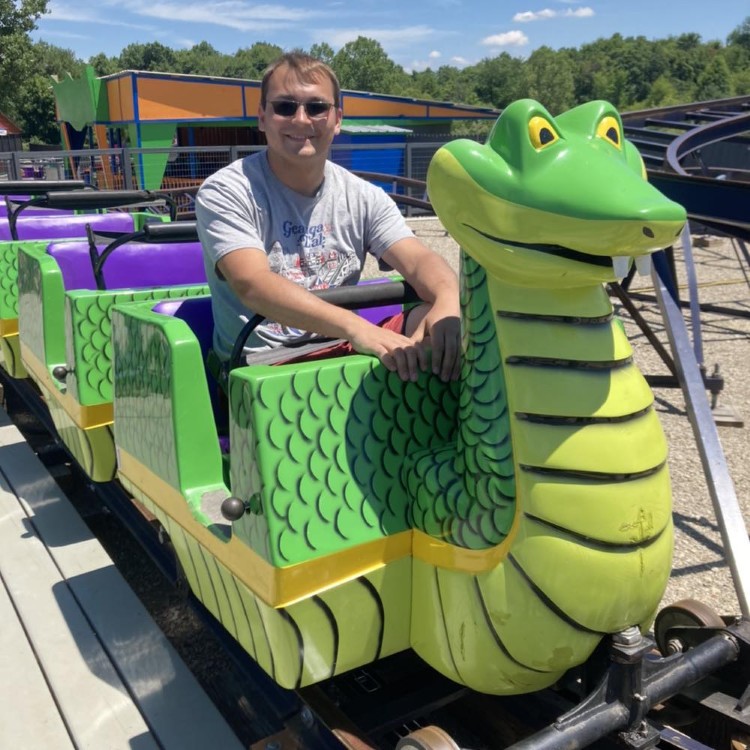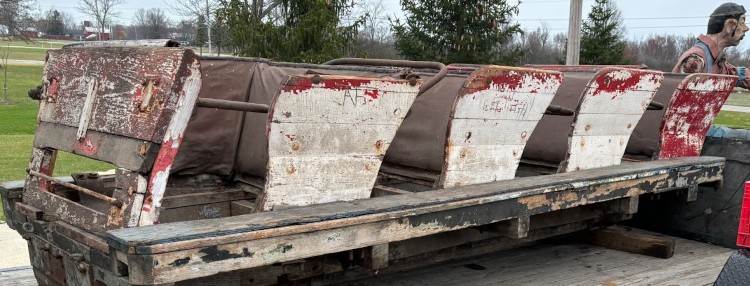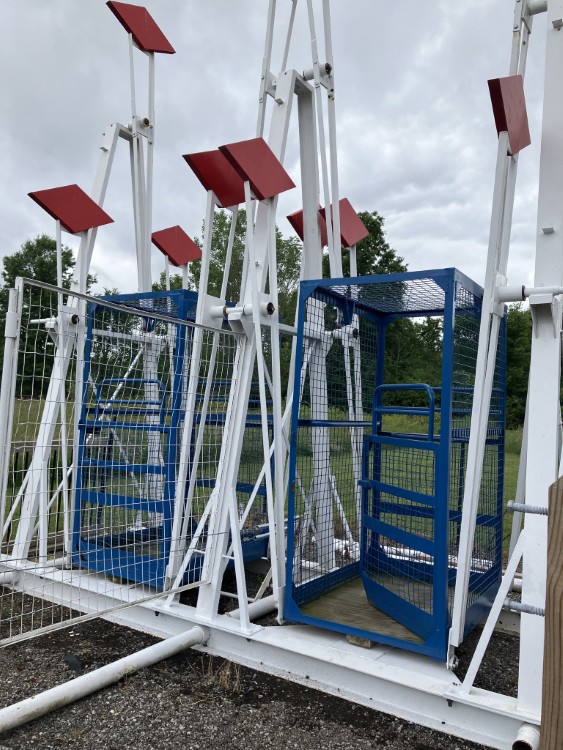Amusement Preservation Museum: Triggering memories of parks and rides of the past
On the outskirts of Grafton, a quaint country village in Lorain County, a country road leads past the usual barns and dairy cows to an unexpected attraction: The Parsh family property in Grafton is home of the Amusement Preservation Museum, where owner Troy Parsh preserves and restores the rides, parts, and other nostalgia of Northeast Ohio’s amusements parks of the past.
On Sunday, June 8, I stopped by the museum’s annual open house.
The smell of hotdogs, Euclid Beach popcorn balls, and other favorite carnival concessions filled the air as attendees were treated to a display of their favorite rides and attractions of the past.
Parsh’s collection has artifacts from 30 Ohio parks, including Euclid Beach Park, Geauga Lake, Chippewa Lake Park, Conneaut Lake, and Cedar Point.
As I arrived at the museum, music filled the air—bringing visitors a sense of anticipation as they discussed memories of their favorite amusement rides. The event offered attendees the opportunity to take selfies in the restored Raging Wolf Bobs cars from the former Geauga Lake. Small-scale models of rollercoasters, a carousel, and the rocket cars were on display.
Kevin Smith of Kevins Northeast Ohio Amusement MemoriesKevin Smith, founder of Kevin’s Northeast Ohio Amusement Memories (KNOAM) had a tent at the museum, displaying KNOAM memorabilia. Smith says his first acquisition in his collection was a Euclid Beach pocketknife, adding that he is also excited about his newest addition: a ride operator’s phone from Euclid Beach’s Thriller roller coaster.
At the June 8 event, small-scale 3-D printed models of amusement park signs and rides from the Northeast Ohio parks were on sale, while a pair of fully-restored Swingin' Gyms from Sauzer’s Kiddieland in Schererville, Indiana were available for patrons to ride.
The Swingin’ Gyms, also known as “The Flying Cages,” are one of only two remaining operational Swingin’ Gyms in the United States.
Admission to the open house was free, so guests could relieve their favorite memories while taking in the sights, sounds, and smells of their favorite amusement parks. Visitors were encouraged to reach out and touch their favorite rides.
Both museum owner Parsh and KNOAM’s Smith asked attendees to share their memories of old amusement parks for Kevin’s Northeast Ohio Amusement Memories page on Smith’s site. They were encouraged to add new memories for the page if they visit historic amusement parks still in existence.
The collections and displays at the Museum, not to mention the sensory stimuli, will trigger amusement park, roller coaster, or carousel enthusiasts to take a trip through nostalgic memories. Parsh and Smith will guide you down this memory lane full of history, favorite parks, and most notable rides at some of Northeast Ohio amusement parks of the past.
An early fascination
Twenty-five-year-old museum founder Troy Parsh, a mechanical engineer, says he enjoys preserving park enthusiasts’ memories by refurbishing the rides that thrilled them.
 Troy Parsh in the Dragon Wagon rideHe recalls riding his first roller coaster, the Dragon Wagon at the IX Indoor Amusement Park. "The following year when we returned, I was tall enough to ride the Wild Mouse, which started my fascination with understanding the mechanicals of amusement park rides,” he says. “The line was set up so you waited alongside the lift hill. As the cars traversed the track I remember watching the wheels track smoothly around the curve and watching the ride connect to the chain and it seemed like a mechanical dance the way the ride functioned.”
Troy Parsh in the Dragon Wagon rideHe recalls riding his first roller coaster, the Dragon Wagon at the IX Indoor Amusement Park. "The following year when we returned, I was tall enough to ride the Wild Mouse, which started my fascination with understanding the mechanicals of amusement park rides,” he says. “The line was set up so you waited alongside the lift hill. As the cars traversed the track I remember watching the wheels track smoothly around the curve and watching the ride connect to the chain and it seemed like a mechanical dance the way the ride functioned.”
Many various parts had to operate in a specific way for the ride to function,” Parsh continues, “and at that point I had known that I wanted to be a part of the creation of these devices."
Subsequent summer family visits to Geauga Lake and Cedar Point further increased Parsh’s fascination with amusement park history.
"I became interested in the history of parks after Geauga Lake closed and it made me realize that these parks are as temporary as anything else," he reflects. “As I got older, I realized how important it is to preserve history and parks as we experience them. There is a chance that the amusement park may close for the winter and never open their gates again."
The 2007 closure of Geauga Lake would later inspire Parsh to acquire and preserve artifacts pertaining to the park's history. His first Geauga Park artifact was a pair of Raging Wolf Bobs roller coaster cars, which he found from a Chicago collector in 2017, who was going to scrap the cars later that summer.
 Chippewa Lake's Big Dipper carParsh was still in high school at the time, so his father, Rob, helped him transport the cars so he could begin restoration—Troy focused on the metalwork while Rob repaired the wood components.
Chippewa Lake's Big Dipper carParsh was still in high school at the time, so his father, Rob, helped him transport the cars so he could begin restoration—Troy focused on the metalwork while Rob repaired the wood components.
Parsh says the experience helped cement his life’s work. “[I] found [my] calling through seeing everyone reliving their childhood memories of Geauga Lake and telling stories about the Raging Wolf Bobs roller coaster ride," he says. “After acquiring the Raging Wolf Bob cars, I felt the need to rescue other parts of amusement history from being lost forever.”
After the Raging Wolf Bob cars, Parsh’s collection grew to include artifacts from Cedar Point, Chippewa Lake Park, Columbus Zoo, Conneaut Lake Park, Dollywood, Dorney Park, Euclid Beach, and Sauzer's Kiddieland. He says his training as a mechanical engineer was good background for the restoration work.
Parsh displays his artifacts at the annual Sights and Sounds of Euclid Beach Park event at the Cleveland Metroparks Euclid Beach and he hosts the yearly open house on his property, which he says is in a temporary museum space as he searches for a permanent location.
Euclid Beach coasters and their designers
 Euclid Beach roller coasterThe oldest addition to date in the museum’s collection is two 1913 roller coaster cars from the Derby Racer roller coaster, which operated at Euclid Beach Park and was a wooden mobius dual-track racing coaster designed by John Miller. The coaster ran the same train type as the Aero Dips roller coaster, Miller's first coaster designed at Euclid Beach. When the Aero Dips closed, parts from the cars were used on the Derby Racer. Parts from the cars date back to 1909.
Euclid Beach roller coasterThe oldest addition to date in the museum’s collection is two 1913 roller coaster cars from the Derby Racer roller coaster, which operated at Euclid Beach Park and was a wooden mobius dual-track racing coaster designed by John Miller. The coaster ran the same train type as the Aero Dips roller coaster, Miller's first coaster designed at Euclid Beach. When the Aero Dips closed, parts from the cars were used on the Derby Racer. Parts from the cars date back to 1909.
The Derby Racer operated from 1913 to 1969 and cost $45,000 to build. The coaster was modified in the early 1940s by Howard Stoneback, designer of the 1924 Euclid Beach’s Flying Turns roller coaster. The ride was renamed the Racing Coaster to avoid confusion with the similarly named Great American Racing Derby carousel ride.
Miller was considered by historians as a preeminent roller coaster designer, builder, inventor, and businessman considered the "father of the modern high-speed roller coaster. He patented more than 100 key roller coaster components and designed over 150 roller coasters over his lifetime.
In the Cleveland area, Miller designed the Geauga Lake Big Dipper; Euclid Beach Flying Turns; Luna Park Pippin, and Puritas Springs Cyclone roller coasters.
Euclid Beach Park was one of the best-known amusement parks in the United States during the first half of the 20th century. Modeled after New York’s Coney Island, the park opened in 1895.
Euclid Beach Park occupied 90 acres of lakefront property near the Collinwood-Euclid border and grew under the Humphrey family’s management—offering unique attractions, amusement, food, and recreational resources in a family-friendly environment.
On September 8, 1969, Euclid Beach Park “closed for the season” for the final time—due to changing times, rising operational costs, and protests over racial incidents.
In 2021, Parsh acquired the Euclid Beach Racing Coaster cars from a donor in Cleveland who removed the abandoned cars from the woods of the previous owner where they sat for 20 years. After Euclid Beach Park closed, the cars were purchased by an ice cream parlor where they sat outside for years resulting in the deteriorated condition of the cars. Parsh mentioned that "he plans to keep the cars intact for historical preservation purposes."
Parsh says he "considers Euclid Beach to be the first great park in the Cleveland area. Although the park has been closed for half a century, people who visited still have fond and vivid memories of their first terrifying experience of Flying Turns—their first trip with their school after getting straight As on their report card—or having their first date and sharing Euclid Beach Custard."
Ride Restoration Process
Donations of artifacts to the museum vary in condition. When a ride is acquired a decision is made to restore or leave as found. An assessment of whether or not more artifacts are in existence and what the story of the current condition tells. For example, a restoration plan was created with the Raging Wolf Bob cars because of severe rotting and deterioration.
 Swingin’ Gyms, or the Flying Cages, at Sauzer’s Kiddieland in Indiana"The Swingin' Gyms Sauzers Kiddieland in Schererville, Indiana and the Lenape Park coaster in New Jersey were the most challenging restorations to date as hundreds of hours were put into ensuring the history of the rides was preserved through meticulous restoration of old and new wood/metal parts to keep the rides as original as possible" says Parsh.
Swingin’ Gyms, or the Flying Cages, at Sauzer’s Kiddieland in Indiana"The Swingin' Gyms Sauzers Kiddieland in Schererville, Indiana and the Lenape Park coaster in New Jersey were the most challenging restorations to date as hundreds of hours were put into ensuring the history of the rides was preserved through meticulous restoration of old and new wood/metal parts to keep the rides as original as possible" says Parsh.
Restoration for each artifact can take up to four years and Parsh stresses that "funds donated to the museum are used towards restoration expenses."
He says his next restoration project will be the Tilt-A-Whirl ride from the former Geneva-on-the-Lake’s Erieview Park (Pera’s Kiddyland).
Amusement park site, artifact, and ride preservation efforts are active in Northeast Ohio through the collective efforts of organizations like the Cleveland History Center, the Chippewa Lake Historical Society, the Merry-Go-Round Museum, the Euclid Beach Boys, and the Aurora Historical Society. Recent media attention has been given to the rejuvenation of the Geauga Lake/Sea World; Chippewa Lake Park; and Euclid Beach park/mobile home sites.
Parsh works tirelessly to preserve not only amusement park rides but countless artifacts. His museum holds an extensive archive of photos, maps, brochures, signage, and blueprints from amusement parks that are exhibited in libraries, museums, and historical societies.
Parsh's vision for the future is to have a full-time museum set up somewhere in Northern Ohio. Through Parsh's dedication, important amusement park artifacts destined for the scrapyard or burn pile were saved preserving "American amusement park history." Parsh hopes that the Amusement Preservation Museum's artifacts & rides will “preserve the past traditions gone by for the kids of tomorrow.”
This article is in memory of Parsh’s mentor, John Frato, who was Cleveland History Center Carousel operations coordinator, president of Euclid Beach Now, and the executive board secretary for the Euclid Beach Carousel Society. His tireless efforts saved the Euclid Beach Carousel.










